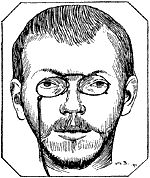Taarnet
| Editor | Johannes Jørgensen |
|---|---|
| Categories |
|
| Frequency | Monthly |
| Founder | Johannes Jørgensen |
| Founded | 1893 |
| First issue | October 1893 |
| Final issue | September 1894 |
| Country | Denmark |
| Based in | Copenhagen |
| Language | Danish |
Taarnet (Danish: The Tower) was a monthly art and literary magazine founded and edited by Johannes Jørgensen in Copenhagen, Denmark. It was subtitled as Illustreret Tidsskrift for Kunst og Litteratur (Danish: Illustrated Magazine for Arts and Literature). The magazine was one of the early avant-garde publications[1] and the major representative of symbolism in Denmark. It existed for one year between 1893 and 1894.[2][3]
History and profile[edit]

Taarnet was founded in 1893 by Johannes Jørgensen who formulated his symbolism approach in the publication.[4][5] The title of the magazine was a reference to both the poetic meaning of tower and the tower in Jørgensen's apartment in Frederiksberg, Copenhagen.[5] In his autobiography Jørgensen stated that Taarnet was established in the name of Edgar Allan Poe, Charles Baudelaire and Paul Verlaine.[6] The first issue appeared in October 1893.[4] The magazine which was published on a monthly basis featured articles on Danish and international symbolist literature and visual art.[4][6]
As stated above Jørgensen described his own version of symbolism in Taarnet and argued "all genuine art is and becomes symbolic."[5] Furthermore, in the magazine Jørgensen replied the critics of his manifesto that he had published in another Danish magazine, Tilskueren.[7] The mission of Taarnet was to provide a connection between French and Danish symbolism, and nearly twenty percent of all articles published in the magazine were translations of French symbolists.[6]
In his articles Jørgensen also supported more mystical and spiritual ways of life.[8] Another notable contributor of the monthly was Sophus Claussen.[5] Danish writer Viggo Stuckenberg published the first scene of his play Den vilde Jæger in the magazine[1] which also featured early drawings by Svend Hammershøi.[5] Other major Danish writers associated with the magazine were Sophus Michaëlis, Mogens Ballin and Jens Ferdinand Willumsen.[1]
Taarnet folded in September 1894 after producing nine issues.[4][6]
References[edit]
- ^ a b c Marie-Louise Zervides (2020). "Nielsen, Saul and David and the Symbolist Movement". Carl Nielsen Studies. VI: 97, 101.
- ^ Jason Harding (November 2015). "European Avant-Garde Coteries and the Modernist Magazine" (PDF). Modernism/modernity. 22 (4): 816. doi:10.1353/mod.2015.0063. S2CID 147574666.
- ^ Béatrice Joyeux-Prunel (Spring 2015). "Provincializing Paris. The Center-Periphery Narrative of Modern Art in Light of Quantitative and Transnational Approaches". Artl@s Bulletin. 4 (1): 47.
- ^ a b c d "Johannes Jørgensen og Taarnet" (in Danish). Kunsten. Retrieved 9 September 2021.
- ^ a b c d e Daniel M. Grimley (2010). Carl Nielsen and the Idea of Modernism. Woodbridge: Boydell. p. 28. ISBN 978-1-84383-581-3.
- ^ a b c d David J. Mickelsen (December 1977). "Beating Frenchmen into Swords: Symbolism in Denmark". Comparative Literature Studies. 14 (4): 328–345. JSTOR 40245910.
- ^ Lief Sjőberg (1984). "Symbolism in Denmark". In Anna Balakian (ed.). The Symbolist Movement in the Literature of European Languages. Comparative History of Literatures in European Languages. Amsterdam; Philadelphia, PA: John Benjamins Publishing Company. p. 589. doi:10.1075/chlel.ii. ISBN 978-90-272-8642-0.
- ^ Margaretta Jolly, ed. (2013). Encyclopedia of Life Writing: Autobiographical and Biographical Forms. London; Chicago: Routledge. p. 507. ISBN 978-1-136-78744-7.
- 1893 establishments in Denmark
- 1994 disestablishments in Denmark
- Danish-language magazines
- Defunct literary magazines published in Europe
- Defunct magazines published in Denmark
- Literary magazines published in Denmark
- Magazines established in 1880
- Magazines disestablished in 1924
- Magazines published in Copenhagen
- Monthly magazines published in Denmark
- Symbolism (arts)
- Visual arts magazines
